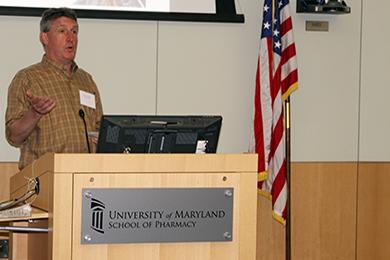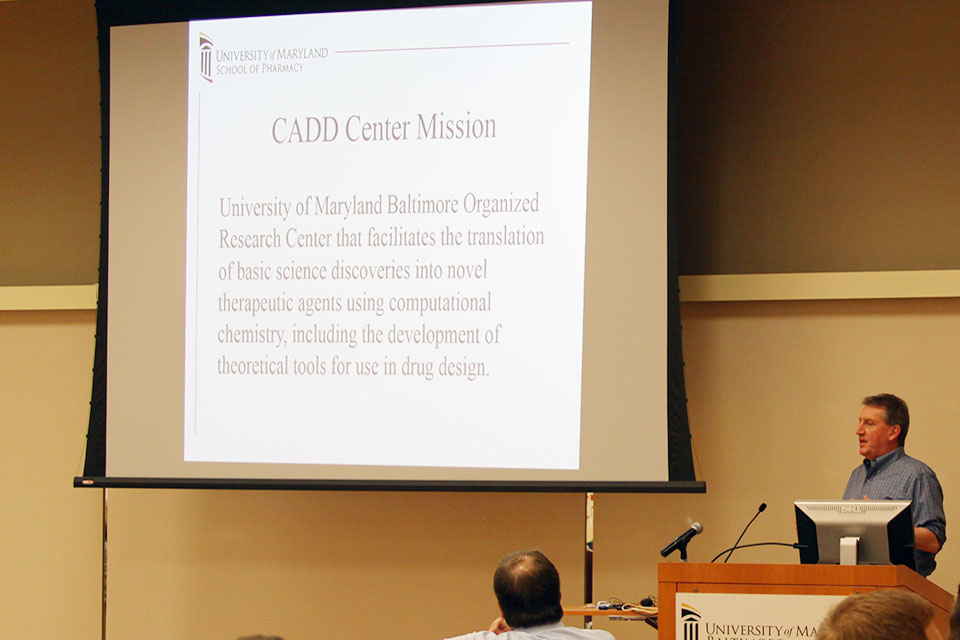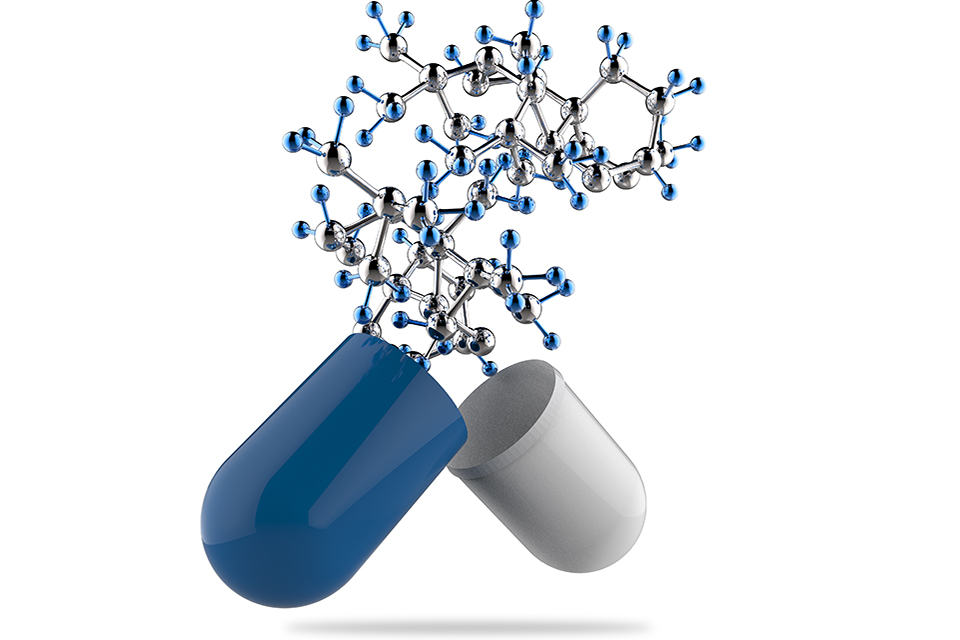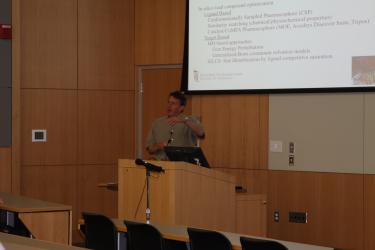School of Pharmacy Hosts Symposium on Computer-Aided Drug Design
Leaders in academia, government, and industry highlight latest research and advances in the field.

By Malissa Carroll
July 14, 2014
The University of Maryland School of Pharmacy welcomed researchers from academia, government, and industry to its Computer-Aided Drug Design (CADD) Symposium on June 24. Hosted by Alexander MacKerell, PhD, the Grollman-Glick Professor of Pharmaceutical Sciences and director of the School’s CADD Center, the symposium presented recent developments in computer-aided drug design and discovery and offered opportunities for researchers throughout the University System of Maryland and beyond to network and discuss potential collaborations.
“The Department of Pharmaceutical Sciences (PSC) is dedicated to advancing basic, translational, and clinical research across the fields of drug discovery and development,” said Andrew Coop, PhD, professor of chair of PSC, in his welcoming remarks to the symposium’s attendees. “One of the most remarkable elements of the CADD Symposium is that it is designed to not only highlight the latest advances in computational chemistry, but also the field’s applications in solving important biological and clinical problems. The symposium also aligns with our department’s entrepreneurial spirit, providing researchers like you with information about how to translate your scholarly activities into marketable initiatives.”
MacKerell kicked-off the symposium with an overview of the School’s CADD Center, discussing its areas of emphasis in ligand-based drug design, target-based drug design, biologicals, methods development, and entrepreneurship, and spotlighting a number of different studies in which its researchers have been involved.
“The CADD Center at the School of Pharmacy is one of only a handful of Organized Research Centers at the University of Maryland, Baltimore (UMB),” said MacKerell. “It was created to foster collaborative research among biologists, biophysicists, and computational scientists across the University and beyond to aid in the discovery of novel chemical entities with the potential to be developed into therapeutic agents. We are focused on turning basic science into therapeutics that can be used to improve human health.”
Sponsored by the School of Pharmacy, SilcsBio LLC, and Early Charm Ventures, the symposium featured presentations from a number of the School’s faculty, including David Goodlett, PhD, the Issac E. Emerson Chair in Pharmaceutical Sciences and director of the School’s Mass Spectrometry Center, who in his presentation proposed to MacKerell a collaboration on a future project to develop vaccine adjuvants targeting the different structures of a unique molecule, known as Lipid A, that is found in Gram-negative bacteria.
“We are confident that we have now uncovered enough structures that we can now begin to perform modeling simulations using resources available through the CADD Center to predict which structures are going to trigger the best immune response,” Goodlett said.
Additional presenters from the School of Pharmacy included Coop, whose lecture spotlighted next generation opioid pain relievers; Hongbing Wang, PhD, associate professor in PSC, who spoke about novel activators of the constitutive androstane receptor (CAR ) using integrated computational and biological approaches; Jana Shen, PhD, associate professor in PSC and co-director of the CADD Center, whose presentation discussed stimuli-responsive vehicles for drug delivery; and Amanda Oglesby-Sherrouse, PhD, assistant professor in PSC, who addressed the regulation of virulence by iron-regulated small ribonucleic acids (RNA) in Pseudomonas aeruginosa.
Embracing the Center’s entrepreneurial spirit, the symposium also included a presentation by Brandon Shue, Esq., patent attorney and intellectual property officer in the Office of Technology Transfer at UMB. Shue spoke about the University’s commitment to helping faculty bring their new technologies into commercial development, highlighting the recently launched Maryland Innovation Initiative and its mission to provide grants to faculty working to develop promising new technologies. “If you have a new technology that you think might hold some commercial value – whether it’s a vaccine, medical device, or repurposed drug – you should reach out to our office. We’re here to help,” he emphasized.
Other presentations were delivered by Paul Wilder, PhD, assistant professor of biochemistry and molecular biology at the University of Maryland School of Medicine; Rodrigo Andrade, PhD, associate professor of chemistry at Temple University; Suresh Singh, PhD, director of modeling at Vitae Pharmaceuticals; Lai-Xi Wang, PhD, professor of biochemistry and molecular biology at the University of Maryland School of Medicine; Alan Graves, PhD, research scientist in computational chemistry at GlaxoSmithKline; Eric deLeeuw, PhD, assistant professor of biochemistry and molecular biology at the University of Maryland School of Medicine; and Marc Nicklaus, PhD, senior scientist and head of the Computer-Aided Drug Design Group at the Center for Cancer Research within the National Cancer Institute.
The symposium concluded with a poster session that offered attendees the opportunity to learn more about the cutting-edge research being conducted across the region.
“My work primarily focuses on dynamic simulations, which immediately follows computer-aided drug design in the drug development process,” says Brittany Davis, a graduate student at the University of Maryland, Baltimore County. “This symposium has opened my eyes to a new perspective. It’s amazing to see all of the groundbreaking research that is being conducted in this field. I’m learning about a lot of new programs and enjoying this great opportunity to network and meet with people who could become my future mentors and collaborators.”



